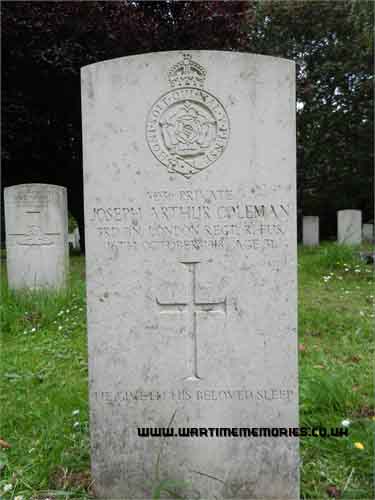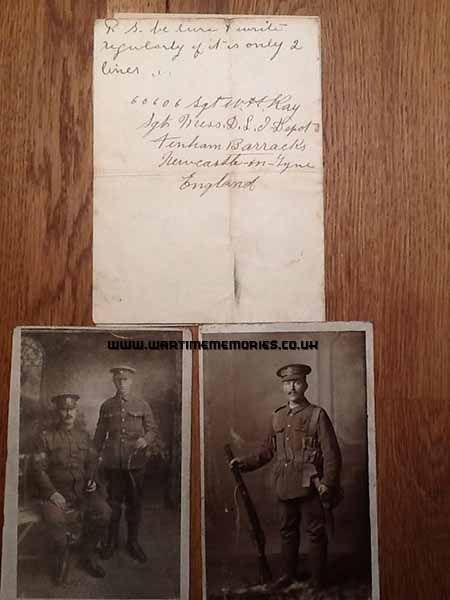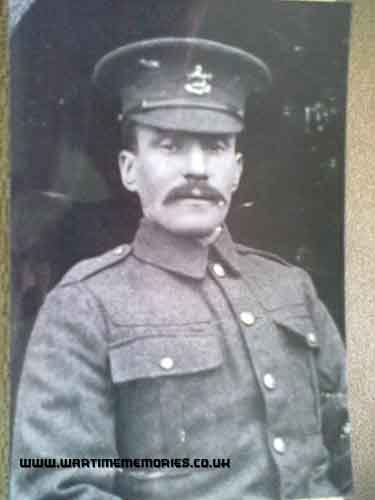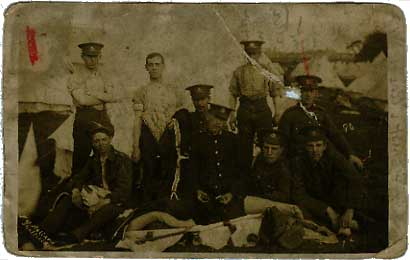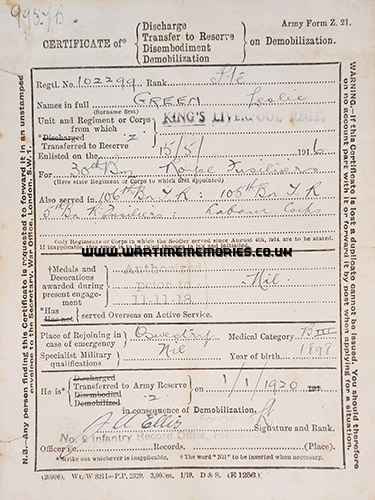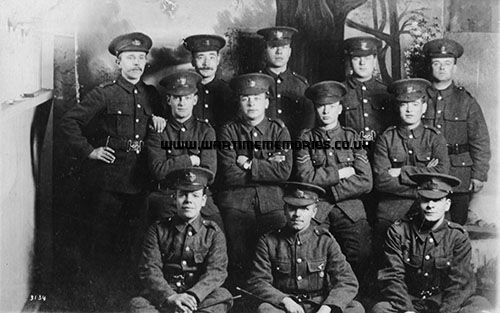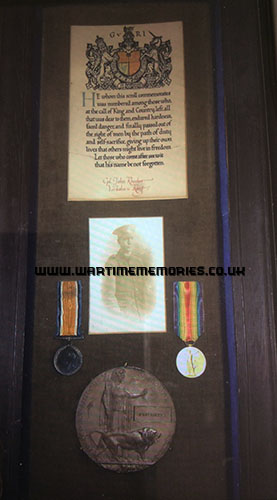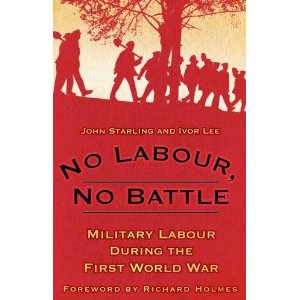|
|
|
Labour Corps
21st Coy. Labour Corps was formed from the 13th (Labour) Battalion, Leicestershire Regiment in 1917. They served on the Western Front as part of Third Army.
20th Coy. Labour Corps was formed from the 13th (Labour) Battalion, Leicestershire Regiment in 1917. They served on the Western Front as part of Third Army.
No.7 Company, Labour Corps was formed in 1917 by the redesignation of 9th (Labour) Battalion, Cameron Highlanders.
No.1 Company, Labour Corps was formed in 1917 by the redesignation of half of the 19th (Labour) Battalion, Royal Scots.
No.2 Company, Labour Corps was formed in 1917 by the redesignation of half of the 19th (Labour) Battalion, Royal Scots.
No.3 Company, Labour Corps was formed in 1917 by the redesignation of half of the 14th (Labour) Battalion, Scottish Rifles.
No.4 Company, Labour Corps was formed in 1917 by the redesignation of half of the 14th (Labour) Battalion, Scottish Rifles.
No.5 Company, Labour Corps was formed in 1917 by the redesignation of half of the 12th (Labour) Battalion, Black Watch.
No.6 Company, Labour Corps was formed in 1917 by the redesignation of half of the 12th (Labour) Battalion, Black Watch.
No.8 Company, Labour Corps was formed in 1917 by the redesignation of half of the 9th (Labour) Battalion, Cameron Highlanders.
No.9 Company, Labour Corps was formed in 1917 by the redesignation of the 1st Infantry Labour Company, Royal Scots Fusiliers.
No.10 Company, Labour Corps was formed in 1917 by the redesignation of the 2nd Infantry Labour Company, Royal Scots Fusiliers.
No.11 Company, Labour Corps was formed in 1917 by the redesignation of the 3rd Infantry Labour Company, Royal Scots Fusiliers.
25th of September 1915 Overcrowded Billets
27th of September 1915 TM Battery Arrives
8th of October 1915 German Dud Shell
9th of October 1915 Artillery Regrouped
20th of October 1915 Reliefs and Moves
21st of October 1915 Relieved by the French
23rd of October 1915 French Take Over Front
24th Oct 1915 Entrenching 
25th Oct 1915 Defence Works 
26th Oct 1915 Defence Works 
27th Oct 1915 Defence Works 
28th Oct 1915 Defence Works 
29th Oct 1915 Defence Works 
30th Oct 1915 Defence Works 
31st Oct 1915 Defence Works 
4th Feb 1916 Construction Work 
5th June 1916 Orders issued to Glasgow Yeomanry
17th June 1916 Orders received
4th August 1916 Rapid Fire Heard
8th of August 1916 Patrols Out 
May 1917 17th Yorks & Lancs disbanded 17th Battlion York and Lancaster disbanded to form 30th and 31st Labour Companies of the Labour Corps in May 1917.
12th June 1917 Hostile Artillery very quiet.
25th July 1917 Instructions for Limbered Wagons 
24th Nov 1917 Transfer
23rd of April 1918 Quiet Spell Broken 
6th of June 1918 Enemy Raid Defeated 
If you can provide any additional information, please add it here.
|
| Want to know more about Labour Corps? There are:5272 items tagged Labour Corps available in our Library There are:5272 items tagged Labour Corps available in our Library 
These include information on officers, regimental histories, letters, diary entries, personal accounts and information about actions during the Great War.
|
|
|
|
The Wartime Memories Project is the original WW1 and WW2 commemoration website.

- 1st of September 2024 marks 25 years since the launch of the Wartime Memories Project. Thanks to everyone who has supported us over this time.
|
Want to find out more about your relative's service? Want to know what life was like during the Great War? Our
Library contains many many diary entries, personal letters and other documents, most transcribed into plain text.
|
Looking for help with Family History Research?
Please see Family History FAQ's
Please note: We are unable to provide individual research.
|
|
Can you help?
The free to access section of The Wartime Memories Project website is run by volunteers and funded by donations from our visitors.
If the information here has been helpful or you have enjoyed reaching the stories please conside making a donation, no matter how small, would be much appreciated, annually we need to raise enough funds to pay for our web hosting or this site will vanish from the web.
If you enjoy this site
please consider making a donation.
Announcements
- 19th Nov 2024
Please note we currently have a massive backlog of submitted material, our volunteers are working through this as quickly as possible and all names, stories and photos will be added to the site. If you have already submitted a story to the site and your UID reference number is higher than
264989 your submission is still in the queue, please do not resubmit.
Wanted: Digital copies of Group photographs, Scrapbooks, Autograph books, photo albums, newspaper clippings, letters, postcards and ephemera relating to the Great War. If you have any unwanted
photographs, documents or items from the First or Second World War, please do not destroy them. The Wartime Memories Project will give them a good home and ensure that they are used for educational purposes. Please get in touch for the postal address, do not sent them to our PO Box as packages are not accepted.
|
World War 1 One ww1 wwII greatwar great battalion regiment artillery
Did you know? We also have a section on World War Two. and a
Timecapsule to preserve stories from other conflicts for future generations.
|
|
|
Gnr. John Miller 177th Bde. Royal Field Artillery (d.30th Oct 1917) Gunner John Miller, 31509 177th Royal Field Artillery was my Great-Grandfather who died whilst serving in Ireland. He is buried in the Curragh Cemetery, just outside Dublin. John was transferred to the 320th Home Service Company Labour Corp at some point and he was serving with them at the time of his death.
I have always been told that John had visited the doctor a number of times complaining of headaches, only to be sent away without further investigation. Sadly, on 30th October 1917, John died whilst on duty and it was discovered that he had suffered a brain haemorrhage.
John's wife Ellen was a strong lady and having just lost her husband and having a young daughter, Kathleen, must have kicked up a bit of a stink as she was taken over to Ireland for John's burial on the Curragh in 1917.
At the bottom of John's headstone, there is the inscription "Always remembered, never forgotten" and he hasn't been. I visited his grave for my 30th birthday in 2000 and plan to go back soon - hopefully, 2017.
I know that the Curragh Barracks were handed back to the Irish in 1922 but feel very sad that the War Graves in the Curragh Cemetery are not tended with the same respect and dedication that I have seen in every other war cemetery (both WWI and WWII) that I have visited. It appears sufficient to chuck a couple of sheep over the wall and leave them to keep the grass under control, but this piece is about John's story.
|
Pte. Arthur Joseph Ethelbert Coleman 3rd Bn. London Regt (d.16th Oct 1918) My Great Grand Uncle served the 3rd Bn. London Regt (Royal Fusiliers). His Army records may have been destroyed during the bombing of the second world war as cannot find them.
He was injured and sent home to the UK and was put into the 318th Home Service Employment Coy. Labour. later he died as a result of his wounds on 16 October 1918. He was 31. He is buried in the Fulham Cemetery in London with other war dead. He left his wife Mary Ann. I cannot find out any more information which for me is very sad as these men sacrificed everything.
|
Sgt. William Henry Kay 10th Btn. Kings Royal Rifle Corps (d.19th May 1918) William Henry Kay was from a large family that originated in Kimberworth, Yorkshire, having 11 brothers and sisters. He was married to Sarah and they had three children, James, Noah and Jane. He was a blast furnaceman in Middlesbrough before the war and they lived in Grangetown.
He started his military career in September 1914, when he joined the newly formed 10th Battalion Kings Royal Rifle Corps. In June 1916 he was promoted to Sergeant. In Aug 1916 he transferred to the Yorkshire and Lancashire Regiment then in September to the Kings Own Yorkshire Light Infantry.
In March 1917 he was transferred again to the Durham Light Infantry, but was soon moved to the Labour Corps, probably due to ill health. By May 1918 he was back in DLI barracks in Newcastle where he died of a heart attack on the 19 May 1918.
His son James, who was 14 when war broke out, also served, but I can not find any details. He survived the war but died in an accident a few years later.
|
Pte. John Frederick Thorpe 3rd (Reserve) Btn Queens Own Royal West Kent Regiment John Frederick Thorpe served with the 3rd Btn, Royal West Kent Regiment and the Labour Corps. We are researching our grandfather’s military service but we have limited information and would appreciate any further help on his regiment and where they were stationed. He married our grandmother in Suffolk in the early part of 1918 so may have been injured and had to cease military service. The battalion we think he was in was 3rd (Special Reserve). The photograph was taken in Chatham Kent on 16th September 1916
Thank you to anyone who can help us further our research.
|
Pte. Charles Brewin Labour Corps My grandad Charles Brewin was in the Labour Corps from August 28th 1914 to January 1919. He wounded, a gsw to right knee area. His birth place was Bulwell in Nottinghamshire.
|
Pte. Joe Saxon Kings Liverpool Regiment My Great Grandfather Joe Saxon wearing his Kings Liverpool Regiment uniform. I believe his family kept this photo on the wall of the dining room of their home whilst Joe was away. Joe was transferred to the Labour Corps and was in France where he served from 1917-1918 before returning home to his family in Cheshire.
|
James Davies Yorks & Lancs Regt The above post card was sent to my Grandmother from her husband. His regiment was the Yorks and Lancs, number 1538 He finished his army career in the Labour corps due to shrapnel in his legs and came home after the war. I am sure that one of these is Grandad James Davies.
|
Gnr. Arthur Cyril Thompson 325th Brigade Ammunition Column Royal Field Artillery 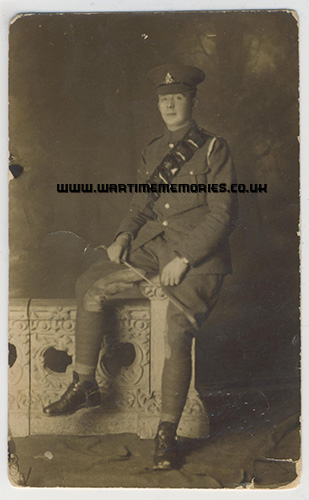 Cyril Thompson enlisted in July 1917 and was sent for training to 81st Infantry Training Reserve Battalion based at Heaton Park Road Schools, Newcastle on Tyne, transferring to Royal Field Artillery (No.1 depot), Fenham Barracks on Barrack Road.
On 27th of December 1917 he was posted to Ireland via Bettisfield Park military training camp (near Chester), arriving in Ireland on 29th of December 1917, stationed with 325th Brigade Ammunition Column, Royal Field Artillery at the Ordnance Barracks, Mulgrave St, Limerick and joined C Battery. Major Traverse Kirkland DSO in charge.
Duties included exercising horses, stables, harness cleaning, parades, gun-laying exercises, stand to exercises, musketry course
29th of January 191a, after being kicked on the head by a horse he was hospitalised for 2 days at New Barracks, light duty (confined to Barracks) for a week
On 19th of April 1918 after Irish Nationalist disturbances in Limerick, the unit moved to Fermoy (Old Barracks?)
On 26th of May 1918 he “Took over the duties as Officer’s Servant for 2/Lt George Bryce Ness, 325th Brigade Ammunition Column.”
Then on 6th of June 1918 they noved to Moore Park Camp, Fermoy and in
August 1918 he returned to Willoughby Waterleys, Blaby, Leics. for a month for agricultural furlough
Cyril 1918-09-05: Returned to his unit 325th BAC RFA at Moore Park on 5th of Sepetmber 1918 and on 10th of October was on the
S.S. Leinster when it was torpedoed by a German Submarine in the Irish Sea on the North Wall to Holyhead Route. 813 people were on board, mostly military personnel going on leave or returning from leave, 569 were lost.
Cyril returned to England on 29th of October 1918 to join the 482nd Agricultural Company, Labour Corps at Glen Parva Barracks and remained on duty at Mr Kirk's dairy farm Barkby Leicestershire and was helping his older brother Bernard on his farm by December 1918.
|
Pte Cornelius Hargreaves 78th Coy. Machine Gun Corps My Grandfather, Cornelius Hargreaves served with 78th Coy, MGC. He died in 1958. All my father can remember is that his Dad served in Mesopotamia.
|
Pte. John Hedges Manchester Regiment John Hedges served with the Manchester Regiment and the Labour Corps.
|
Pte. Leslie Green 5th Btn Royal Fusiliers Leslie Green served with the 4th and 5th Royal Fusiliers and transferred to 786th Area Employment Company, Labour Corps on 25th of October 1917 then back to the Royal Fusiliers on 24th of August 1918. He was with the Kings Liverpool Regiment on discharge.
|
Pte/ George Munn 15th (North Belfast) Btn. Royal Irish Rifles Born on 28th Jan 1895 I know that my grandfather, George Munn joined the 15th Battalion, Royal Irish Rifles as a private. He must have been transferred to the Labour Corps at some time because according to his Unit Register Card he served 4 years 5 months, 2 years 1 month in the field as a private in the Labour Corps (POW) Unit, 376 Prisoner of War Company.
I remember him well, and I remember him telling me that he was wounded on a couple of occasions (shot through & through, and shrapnel wounds), and I remember he once showed me the scars of his wounds, and his hands and arms covered with the black spots of shrapnel.
|
Pte. James Caldwell Argyll and Sutherland Highlanders My great great grandfather, James Caldwell fought during World War One, enlisting on 12th of December 1914 with the Argyll and Sutherland Highlanders, then transferred to the Labour Corps on 26th of November 1917.
He was invalided to the 3rd Scottish Hospital, at Stobhill, Glasgow on 14th of August 1916 before being discharged on 31st of August 1916.
He was later discharged from the forces on 8th of June 1918 due to being physically unfit.
|
Peter Holmes 24th (Sportsmans) Btn. Royal Fusiliers Peter Holmes was married to Florence (nee Armstrong).
At the time of his enlistment in Liverpool (January 1915) he was 36 years old. Height: 5'8", weight: 12st 2lbs, good physical condition, except for defective teeth.
The 24th Battalion, Royal Fusiliers spent the next 11 months training in Nottingham and then on Salisbury Plain, before moving to France in November of 1915 as part of the 99th Brigade, 33rd Division.
The spring of 1916 saw Peter involved on localised operations. When the Battle of the Somme opened Peter and his Battalion were enjoying a period of rest and re-fit. However, this didn't prevent Peter from being injured in action and having to leave the line to recover.
Peter subsequently returned to the regiment and took part in the Battle of Ancre, only to be wounded on the first day.
This necessitated him leaving from the line for a month, before re-joining his Regiment in the area of Festubert, where he was under constant threat from artillery and sniper fire.
In 1918 he joined the Labour Corps serving in an Area Employment Company.
He was appointed Acting Sgt 7th of March 1919 and returned to England to be demobilised on the 12th May 1919, with no disability.
Peter died in the 1945 in Chester Royal Infirmary, Chester. He was my 1st Cousin 2 x removed.
|
Pte. Daniel Patrick Sheen Labour Corps My Grandfather, Daniel Sheen was 28 years old, when he joined the Labour Corps in 1915. He had one eye, having lost his left eye around 1904. His service record states that he was shot in the left leg during the conflict. The only photo I ever had of my Grandfather, was lost many years ago. It was a photo of him in his Labour Corps uniform.
|
Pte. Patrick Creedon MM. 1st Btn Royal Munster Fusiliers Patrick Creedon was born in Cork, Ireland in September 1897.
He served as a Private in the 1st Royal Munster Fusiliers, as an Acting Corporal in the Royal Irish Rifles and an Acting Corporal in the Labour Corps.
Patrick was listed in the Casualty Lists on and was awarded the Military Medal on 23rd of October 1916.
|
Rfmn. Frederick "Jerry" Targett 16th Btn. Rifle Brigade Frederick Targett served with the 16th Battalion, Rifle Brigade since 1915 to 1918 when the 39th Division was disbanded due to losses.
He then served in the Labour Corps.
He survived the war and was demobbed in 1919
receiving the 1914 - 1918 and Victory medals.
He was my maternal grandfather.
|
Pte. Frederick William Earwaker 2nd Btn. Royal Sussex Regiment My grandfather Frederick Earwaker worked at Shippams in Chichester and joined up in 1916. He took part in the assault on High Wood, part of the Battle of the Somme, and was shot in the back on 9th September 1916. He was treated by a German first raider in a shell hole and under cover of darkness and walked to a trench dressing station.
He eventually went to Rouen field hospital where he was operated on and thence via HMHS Asturias to Milton hospital in Portsmouth. By the 22nd November 1916 he was in Castle Hospital convalescing. He described the food as "first rate... rabbit pies, beefsteak, puddings etc. The nurses are very nice here, too". He appears to have left around January 1917, by which point he was at the eastern command unit at Shoreham. He never returned to the front but served out the war in the Labour Corps and the RAF in the UK. He returned to work at Shippams after the war and completed 50 years’ service. He died months short of retirement in 1961.
|
Pte. Frederick Abraham Sellek 14th Btn. Gloucestershire Regiment Frederick Sellek was born in Withycombe on the 28th April 1896. He joined up on the 15th of May 1915 giving his adddress as 10 Park Terrace, Withycombe, Exmouth. He was single, 5' 0", 7 Stone 11 pounds, chest 34" and his occupation is listed as Gardener. He joined the 14th (Bantams) Battalion Gloucester Regimen as a Private. His Next of Kin is given as Eliza Sellek, his mother of 10 Park Terrace, Exmouth.
Frederick transferred to 194th Infantry Company, Labour Corps on the 31st of January 1917 at Dieppe. Then to KSOB on the 12th of July 1918. He transferred to the Z list on 14th of March 1919 giving his home address as
80 The Village, Withycombe Exmouth.
Frederick died in 1976
|
Cpl. John Rhodes 9th Btn Yorkshire Regiment (Green Howards) (d.7th June 1917) John Rhodes served with the 9th Yorkshire Regiment and 10th Coy. Labour Corps.
|
Recomended Reading.Available at discounted prices.
|
No Labour, No Battle: The Labour Corps in the First World War John Starling & Ivor Lee
From 1917 British Soldiers who were unfit or too old for front line service were to serve unarmed and within the range of German guns for weeks or even months at a time undertaking labouring tasks. The vital, yet largely unreported role played by these brave soldiers was crucial to achieving victory in 1918. For this book John Starling and Ivor Lee have brought together extensive research from both primary and secondary sources. It traces how Military Labour developed from non-existent in 1914, to a Corps in November 1918 some 350,000 strong, supported by Dominion and foreign labour of more than a million men. The majority of the Labour Corps did not keep war diaries, therefore this work provides vital information for those wishing to acquire information about an ancestor who served in the Corps.
|
|
|






